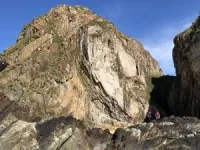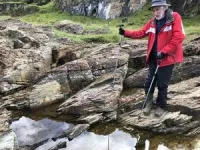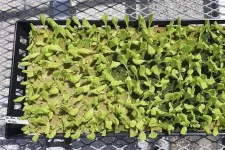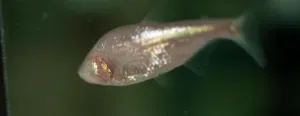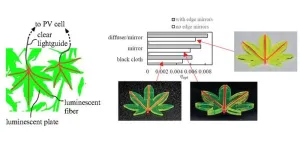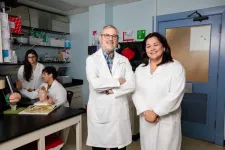(Press-News.org) A rock formation spanning Ireland and Scotland may be the world’s most complete record of “snowball Earth”, a crucial moment in planetary history when the globe was covered in ice, finds a new study led by UCL (University College London) researchers.
The study, published in the Journal of the Geological Society of London, found that the Port Askaig Formation, composed of layers of rock up to 1.1km thick, was likely laid down between 662 to 720 million years ago during the Sturtian glaciation – the first of two global freezes thought to have triggered the development of complex, multicellular life.
One exposed outcrop of the formation, found on Scottish islands called the Garvellachs, is unique as it shows the transition into “snowball Earth” from a previously warm, tropical environment.
Other rocks that formed at a similar time, for instance in North America and Namibia, are missing this transition.
Senior author Professor Graham Shields, of UCL Earth Sciences, said: “These rocks record a time when Earth was covered in ice. All complex, multicellular life, such as animals, arose out of this deep freeze, with the first evidence in the fossil record appearing shortly after the planet thawed.”
First author Elias Rugen, a PhD candidate at UCL Earth Sciences, said: “Our study provides the first conclusive age constraints for these Scottish and Irish rocks, confirming their global significance.
“The layers of rock exposed on the Garvellachs are globally unique. Underneath the rocks laid down during the unimaginable cold of the Sturtian glaciation are 70 metres of older carbonate rocks formed in tropical waters. These layers record a tropical marine environment with flourishing cyanobacterial life that gradually became cooler, marking the end of a billion years or so of a temperate climate on Earth.
“Most areas of the world are missing this remarkable transition because the ancient glaciers scraped and eroded away the rocks underneath, but in Scotland by some miracle the transition can be seen.”
The Sturtian glaciation lasted approximately 60 million years and was one of two big freezes that occurred during the Cryogenian Period (between 635 and 720 million years ago). For billions of years prior to this period, life consisted only of single-celled organisms and algae.
After this period, complex life emerged rapidly, in geologic terms, with most animals today similar in fundamental ways to the types of life forms that evolved more than 500 million years ago.
One theory is that the hostile nature of the extreme cold may have prompted the emergence of altruism, with single-celled organisms learning to co-operate with each other, forming multicellular life.
The advance and retreat of the ice across the planet was thought to have happened relatively quickly, over thousands of years, because of the albedo effect – that is, the more ice there is, the more sunlight is reflected back into space, and vice versa.
Professor Shields explained: “The retreat of the ice would have been catastrophic. Life had been used to tens of millions of years of deep freeze. As soon as the world warmed up, all of life would have had to compete in an arms race to adapt. Whatever survived were the ancestors of all animals.”
For the new study, the research team collected samples of sandstone from the 1.1km-thick Port Askaig Formation as well as from the older, 70-metre thick Garbh Eileach Formation underneath.
They analysed tiny, extremely durable minerals in the rock called zircons. These can be precisely dated as they contain the radioactive element uranium, which converts (decays) to lead at a steady rate. The zircons together with other geochemical evidence suggest the rocks were deposited between 662 and 720 million years ago.
The researchers said the new age constraints for the rocks may provide the evidence needed for the site to be declared as a marker for the start of the Cryogenian Period.
This marker, known as a Global Boundary Stratotype Section and Point (GSSP), is sometimes referred to as a golden spike, as a gold spike is driven into the rock to mark the boundary.
GSSPs attract visitors from around the world and in some cases museums have been established at the sites.
A group from the International Commission on Stratigraphy, a part of the International Union of Geological Sciences, visited the Garvellachs in July to assess the case for a golden spike on the archipelago. Currently, the islands are only accessible by chartering a boat or by sailing or kayaking to them.
The study involved researchers from UCL, the University of Milano-Bicocca, Italy, and Birkbeck University of London. The work was funded by the Natural Environment Research Council (NERC).
END
Scottish and Irish rocks confirmed as rare record of ‘snowball Earth’
A rock formation spanning Ireland and Scotland may be the world’s most complete record of “snowball Earth”, a crucial moment in planetary history when the globe was covered in ice, finds a new study led by UCL researchers.
2024-08-16
ELSE PRESS RELEASES FROM THIS DATE:
Research provides a roadmap for improving electrochemical performance
2024-08-16
Thomas Edison went through thousands of materials before he finally found the right tungsten filament to create a working lightbulb. This type of trial-and-error research continues today and is responsible for countless inventions that improve our world. Battery systems that help power our lives in many seen (and unseen) ways are one example.
However, improving these materials and devices requires more than experimentation. Modern engineers must also form a deeper understanding of the general principles that govern material performance, from which they can design better materials to achieve challenging product requirements.
In a paper ...
Females’ and males’ muscles differ in sugar and fatty acid handling
2024-08-16
Females’ and males’ muscles differ in glucose and fatty acid handling – but regular physical activity quickly triggers similar beneficial metabolic changes in the muscles of both sexes, new research to be presented at this year’s Annual Meeting of the European Association for the Study of Diabetes (EASD) (Madrid, 9-13 September) has found.
Exercise has a potent effect on skeletal muscle and is the most effective strategy to prevent weight loss-related muscle loss and type 2 diabetes. ...
USDA-NIFA awards $300K to study food safety, plant pathogens and pests in hydroponics
2024-08-15
FAYETTEVILLE, Ark. — As controlled environment agriculture and vertical farming gain a greater foothold in modern agriculture, a new $300,000 grant aims to enhance hydroponic lettuce production.
Kristen Gibson, director of the Arkansas Center for Food Safety and Arkansas Agricultural Experiment Station faculty member, is the lead researcher on the grant from the U.S. Department of Agriculture’s National Institute of Food and Agriculture. Gibson says the grant provides an opportunity to meet the needs of the hydroponics industry.
“The industry is always looking for what’s going to help them grow the best product, increase profit and ...
YALE NEWS: Brain wiring is guided by activity even in very early development
2024-08-15
New Haven, Conn. — In humans, the process of learning is driven by different groups of cells in the brain firing together. For instance, when the neurons associated with the process of recognizing a dog begin to fire in a coordinated manner in response to the cells that encode the features of a dog — four legs, fur, a tail, etc. — a young child will eventually be able to identify dogs going forward. But brain wiring begins before humans are born, before they have experiences or senses like sight to guide this cellular circuitry. How does that happen?
In a new ...
Eyes on the field: How Texas A&M researchers are working to revolutionize NFL officiating
2024-08-15
Hamza Memon and Nicholas Panzo, students at Texas A&M University School of Engineering Medicine (ENMED), are leading an innovative project at the intersection of sports and ophthalmology to improve National Football League (NFL) officiating . Rooted deeply in Houston’s vibrant sports culture, these Class of 2026 students combine their interest in ophthalmology and their love for sports to contribute significantly to a groundbreaking project with the NFL.
The two students met during a summer engineering program and quickly bonded over their shared aspirations in sports and ophthalmology. This friendship led ...
Blind cavefish have extraordinary taste buds
2024-08-15
Over thousands of years, cavefish evolved and lost their vision, earning the moniker “the blind cavefish,” but some cavefish also developed an inordinate number of taste buds on the head and chin.
In a new study, now published in the Nature journal Communications Biology, scientists at the University of Cincinnati have determined when the taste buds start to appear in areas beyond the oral cavity. The study was supported by the National Science Foundation.
To begin, blind cavefish evolved in cave ponds in northeastern Mexico. They are pale pink and nearly translucent compared to their silvery counterparts ...
What the trained eye cannot see: Detecting movement defects in early stage Parkinson's disease
2024-08-15
A technique that uses videos and machine learning to quantify motor symptoms in early-stage Parkinson’s disease could help reveal signs of the disease and other movement disorders earlier, which could lead to better treatment outcomes.
In a study just published in Parkinsonism and Related Disorders, a team of researchers from the University of Florida and the Fixel Institute for Neurological Diseases shows that video assessment can help detect early Parkinsonism in an individual by comparing the movement of the left and right sides of their body. The approach, researchers say, exploits the fact ...
Leaf-like solar concentrators promise major boost in solar efficiency
2024-08-15
Since its invention in the 1970s, the luminescent solar concentrator (LSC) has aimed to enhance solar energy capture by using luminescent materials to convert and concentrate sunlight onto photovoltaic (PV) cells. Unlike traditional concentrators that rely on mirrors and lenses, LSCs can harvest diffuse light and have been used in applications such as building-integrated photovoltaics, where their semitransparent and colorful nature offers aesthetic benefits. However, scaling up LSCs to cover large areas has been challenging due to issues like self-absorption of photoluminescent (PL) photons within the waveguide. Researchers ...
UTEP awarded $2.5 M NIH grant to study nicotine dependence in women
2024-08-15
EL PASO, Texas (Aug. 15, 2024) — Researchers at The University of Texas at El Paso will undertake a new study that could lead to improved nicotine cessation treatments for women. The work is supported by a new $2.5 million grant from the National Institute on Drug Abuse (NIDA), part of the National Institutes of Health (NIH).
Principal investigator Laura O'Dell, Ph.D., a professor in the Department of Psychology at UTEP, will lead the multidisciplinary study into how stress produced by nicotine withdrawal is intensified by variations in ovarian hormones in women.
The study ...
DOE announces $10 million to support climate resilience centers across America
2024-08-15
WASHINGTON, D.C. – To support vulnerable communities responding to continued and extreme climate effects, the Department of Energy (DOE) today announced $10 million in funding for innovative Climate Resilience Centers (CRCs) in 10 different states. University-led research teams will leverage the world class modeling, data and research capabilities from DOE national laboratories customized for their local regions with a focus on climate prediction of weather hazard risks to better prepare communities. The CRCs are part of the Biden-Harris Administration’s Justice40 Initiative and are designed to ensure that all Americans are benefitting from scientific research.
“Every ...
LAST 30 PRESS RELEASES:
SIMJ announces global collaborative book project in commemoration of its 75th anniversary
Air pollution exposure and birth weight
Obstructive sleep apnea risk and mental health conditions among older adults
How talking slows eye movements behind the wheel
The Ceramic Society of Japan’s Oxoate Ceramics Research Association launches new international book project
Heart-brain connection: international study reveals the role of the vagus nerve in keeping the heart young
Researchers identify Rb1 as a predictive biomarker for a new therapeutic strategy in some breast cancers
Survey reveals ethical gaps slowing AI adoption in pediatric surgery
Stimulant ADHD medications work differently than thought
AI overestimates how smart people are, according to HSE economists
HSE researchers create genome-wide map of quadruplexes
Scientists boost cell "powerhouses" to burn more calories
Automatic label checking: The missing step in making reliable medical AI
Low daily alcohol intake linked to 50% heightened mouth cancer risk in India
American Meteorological Society announces Rick Spinrad as 2026 President-Elect
Biomass-based carbon capture spotlighted in newly released global climate webinar recording
Illuminating invisible nano pollutants: advanced bioimaging tracks the full journey of emerging nanoscale contaminants in living systems
How does age affect recovery from spinal cord injury?
Novel AI tool offers prognosis for patients with head and neck cancer
Fathers’ microplastic exposure tied to their children’s metabolic problems
Research validates laboratory model for studying high-grade serous ovarian cancer
SIR 2026 delivers transformative breakthroughs in minimally invasive medicine to improve patient care
Stem Cell Reports most downloaded papers of 2025 highlight the breadth and impact of stem cell research
Oxford-led study estimates NHS spends around 3% of its primary and secondary care budget on the health impacts of heat and cold in England
A researcher’s long quest leads to a smart composite breakthrough
Urban wild bees act as “microbial sensors” of city health.
New study finds where you live affects recovery after a hip fracture
Forecasting the impact of fully automated vehicle adoption on US road traffic injuries
Alcohol-related hospitalizations from 2016 to 2022
Semaglutide and hospitalizations in patients with obesity and established cardiovascular disease
[Press-News.org] Scottish and Irish rocks confirmed as rare record of ‘snowball Earth’A rock formation spanning Ireland and Scotland may be the world’s most complete record of “snowball Earth”, a crucial moment in planetary history when the globe was covered in ice, finds a new study led by UCL researchers.

